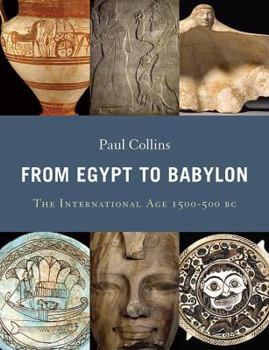From Egypt to Babylon: The International Age 1550-500 BC
Select Format
Select Condition 
Book Overview
For those who believe that globalization is a purely modern phenomenon, this book holds a startling and absorbing lesson. From Egypt to Babylon immerses readers in a world of exotic empires and states as they waxed and waned and interacted in a period of extraordinary internationalism--all before the rise of the Persian Empire. The ancient Egyptians, Minoans, Mycenaeans, Hittites, Canaanites, Hurrians, Aramaeans, Israelites, Urartians, Mannaeans, Assyrians, Phrygians, Kassites, Chaldaeans, Elamites, Scythians, Medes, and Persians: these are the societies who for a millennia peopled the world from the Aegean and Egypt in the west to what we know now as Iraq and Iran in the east. In a concise introduction, illustrated with objects drawn largely from the collections of the British Museum, this book takes the reader through the vast and varied landscape of this period, where a far-flung world was linked by military expansion, diplomatic relations, and movement of goods and peoples that brought about profound cultural exchanges and technological and social revolutions. The story brings the reader from the foundations of the Egyptian empire through the turmoil at the end of the second millennium bce to the unprecedented political unification of the whole region by kings of Persia. From Egypt to Babylon weaves together the political histories of the region's diverse societies for the first time, tracing shifting fortunes and burgeoning colonies, trading connections and cultural pressures in what was truly the world's first international age.
Format:Hardcover
Language:English
ISBN:0674030966
ISBN13:9780674030961
Release Date:October 2008
Publisher:Harvard University Press
Length:208 Pages
Weight:2.05 lbs.
Dimensions:1.0" x 7.6" x 9.7"
Customer Reviews
2 ratings
An excellent historical overview
Published by Thriftbooks.com User , 15 years ago
This book does an impressive job of pulling together the threads of the diverse histories of the ancient world into a coherent fabric that illustrates the relations of these kingdoms to one another. For many readers it will introduce peoples about whom they may know little or nothing, and show how their histories fit into the better known histories of lands such as Egypt and Greece. This book will be of interest to any who have studied any particular ancient civilization and wondered how it fits into the larger tapestry of ancient history. I have only one small problem with this book (and it is a very small one): The author's insistence on using the term "Iraq" rather than "Mesopotamia" throughout his text. He explains it thus in his Preface: "The term Iraq (a name applied to the region of the modern country from at least the sixth century AD) is used in preference to the Greek term Mesopotamia which is becoming less meaningful for younger generations of readers." For someone like me, seeing "Iraq" used 2000 years too early in the context of Mesopotamia is both jarring and distracting. I also submit that avoiding the term "Mesopotamia" is not the best way to combat the trend of it "becoming less meaningful." However, as I said, it is a small point and does little to detract from the overall usefulness of this very useful work.
Excellent Analyses of Ancient International Relations
Published by Thriftbooks.com User , 15 years ago
Paul Collins has written an impeccable book, and its strength lies not only in its careful analytical summations of known ancient Near Eastern history but also especially in its attention to international relations in the time period from the Late Bronze Age to Neo-Babylon. Collins has done justice to what happened in Mesopotamia at the same time as in Egypt and how these regions reacted or responded to each other, with detailed critical understanding of the ebb and flow of power dynamics between these regions (when one was strong, the other usually weaker; when equally strong, a clash was inevitable in the Levantine buffer zone). While I agree with another reviewer that selective cultural highlights would make this book even better (e.g., Gilgamesh only receives a few sentences) - although also possibly making the book too long - this is not its stated historically purposed purview. While I also agree that integration of illustration and text or discussion of illustrations therein, adding to its excellent captions, might improve the book, its many beautiful and iconic images (in keeping with British Museum Press high standards) are lavishly ample and greatly representative of the cultures therein. I will certainly use the book in my next Stanford course on the Ancient Near East, and I hope a paperback edition is forthcoming for university students, for whom it will be the current definitive text.





